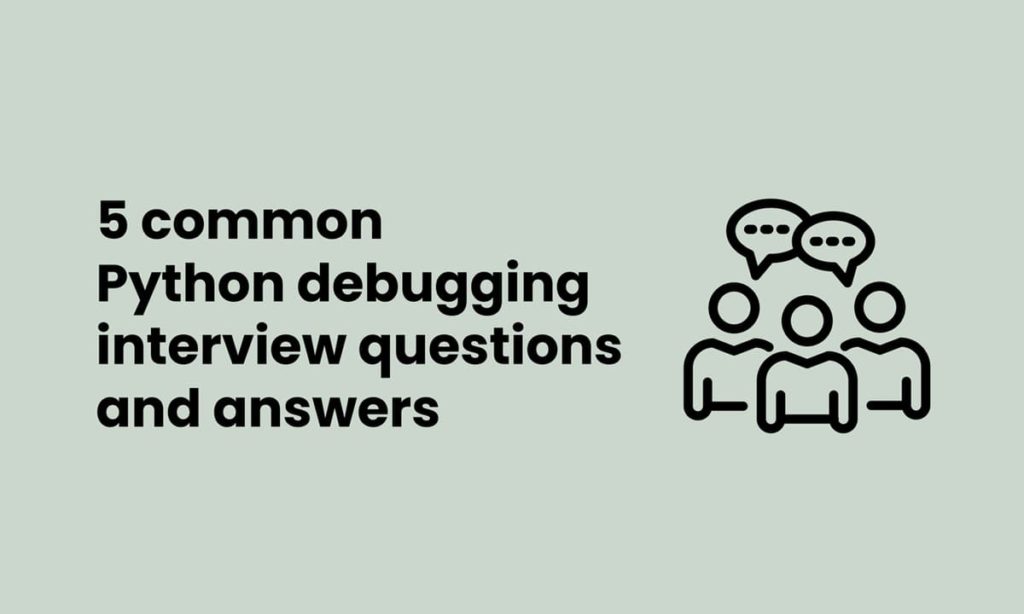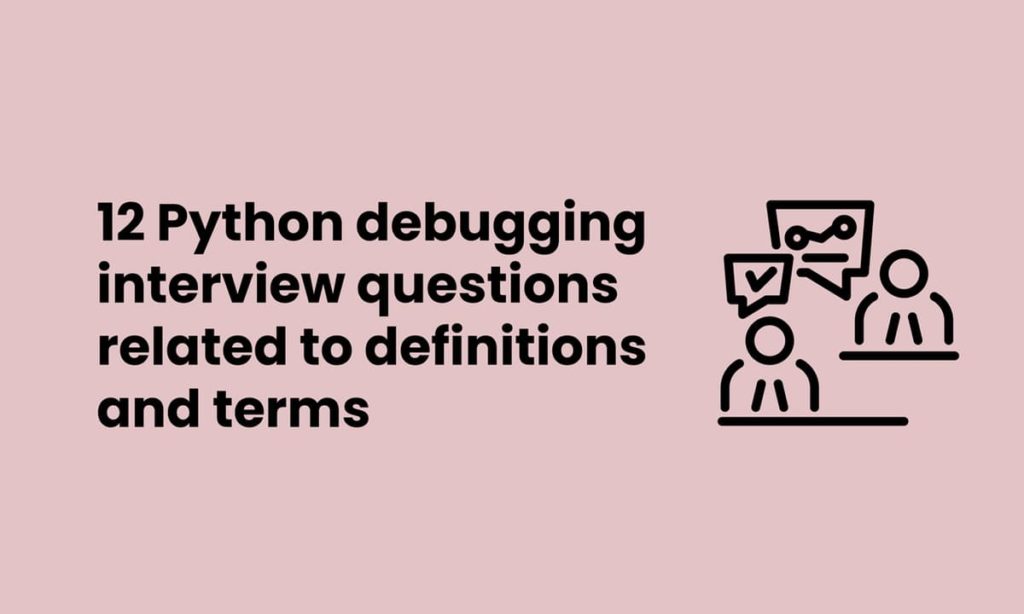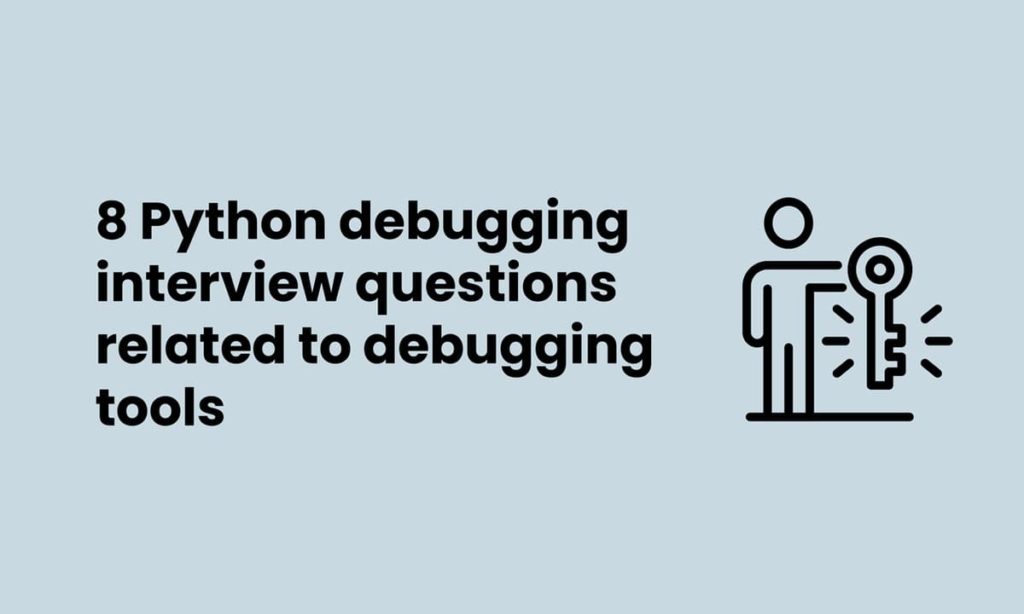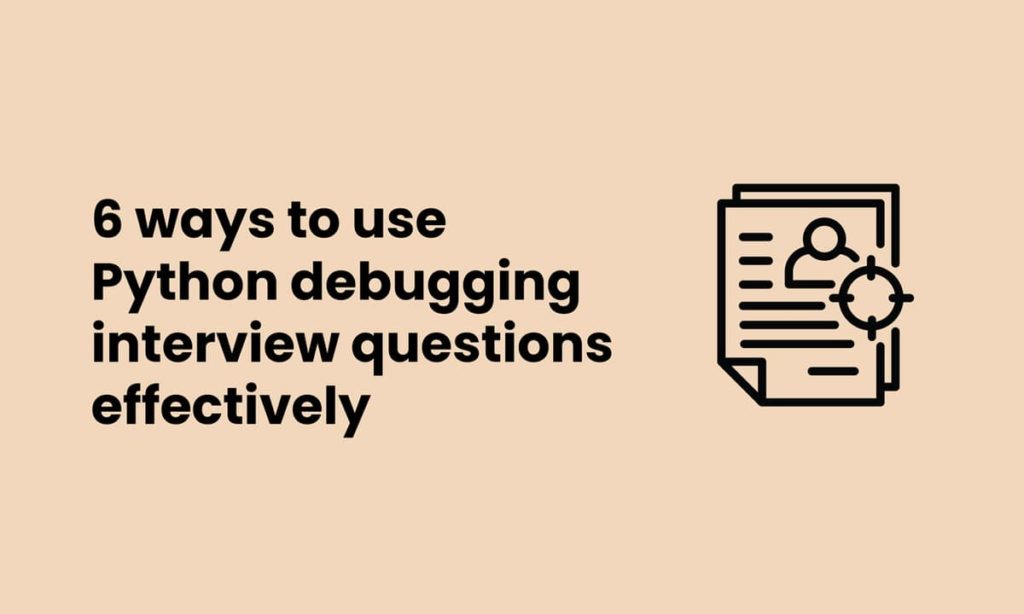25 Python debugging interview questions
Debugging is a critical skill for software developers: It’s vital to ensure that a program is error-free before your organization releases it to the public.
If Python is one of your organization’s programming languages, your developers will also need to know how to debug their code efficiently.
For this reason, when hiring a new programmer, it’s essential to test their skills with a Python Debugging test and, during the interviewing stage, ask them the right set of interview questions.
Take a look at this list of 25 Python debugging interview questions, which will help you make the most of your interviews and hire the right applicant.
Read until the end to find out which other steps can help you hire the right developer.
Table of contents
- 5 common Python debugging interview questions and answers
- 12 Python debugging interview questions related to definitions and terms
- 8 Python debugging interview questions related to debugging tools
- 6 ways to use Python debugging interview questions effectively
- Use TestGorilla and the right set of Python debugging interview questions to hire top talent
5 common Python debugging interview questions and answers
Ask your candidates the five common Python debugging interview questions listed in this section to assess the scope of their Python debugging knowledge.
1. What are the advantages of comments for debugging?
Candidates may explain that developers can understand their code much easier when they return to it after some time, if they have used comments. If programmers need to share their code with others, they also won’t have to explain each line of code to other teams, making debugging easier.
2. Give an example of a free bug tracking tool.
An example of a free bug tracking tool is Bugzilla. Candidates may explain that Bugzilla is an open-source bug tracker that can integrate easily with email systems and test-management instruments.
3. Should all developers use a Python debugger?
Although many junior-level programmers tend to overlook debugging, having a debugging process is important for all developers. Whether you’re a seasoned developer or just starting out, understanding how to locate and fix bugs is crucial.
4. What’s your method for program debugging in Python?
All developers will have their own approaches for debugging programs and solving problems with code as they get more advanced, but a simple approach for efficiently debugging code includes the following steps:
Make an educated guess about which part of the code could have a bug
Set a breakpoint and inspecting the code line by line
Monitor variables as they inspect the code
Determine which line contains an error and making changes to fix it
Repeat the four steps above until you’ve fixed the bug
5. What skills do you need for efficient debugging in Python?
Some vital skills that candidates might mention when responding to this question include:
Unit testing skills
Communication skills (and using comments)
12 Python debugging interview questions related to definitions and terms
In this section, you’ll find 12 Python debugging interview questions related to definitions and terms. With these questions, you can test your candidates’ knowledge on a deeper level.
1. What is debugging in Python?
Candidates should be aware that debugging is a process that developers follow to track down any defects in code. The process involves code instrumentation, inspection, and execution to determine which particular application state doesn’t align with how the code should run.
2. What is a syntax error in Python?
Any mistakes that occur when using the language are referred to as syntax errors. For example, the code will not run correctly if a programmer forgets to use a quotation mark or comma in the code or fails to terminate a vector.
3. What is a run-time error in Python?
A run-time error in Python occurs if the programming language understands the instructions a programmer gives it but cannot follow them. The program may be correct syntactically, but there may be an issue with program execution.
4. What is a logic error in Python?
Candidates should know that logic errors are also referred to as semantic errors. These errors may not cause the program to crash but can cause it to produce the wrong output.
5. What is a Python debugger?
A Python debugger is a program that helps developers determine what’s not working in a computer program by enabling programmers to set breakpoints. The Python debugger also supports code evaluation.
6. Describe what background debug mode is.
Background debug mode is an interface that enables developers to debug embedded systems. This mode facilitates debugging in microcontrollers.
7. What are high-level debugging systems?
A high-level debugging system integrates technologies and source-level debugger tools that developers use to control execution and set breakpoints.
8. What is reactive debugging?
Candidates may explain that reactive debugging involves noticing a defect in the application, finding the error, and fixing it. This process involves using a debugging protocol after a developer has noticed the bug, including using debuggers or a print debugging method.
9. What is a virtualenv?
Virtualenv is also known as a virtual environment. Candidates should know that although Python can’t distinguish between each version in the site-package directory, virtualenv separates each project’s environment and ensures there are no cross-dependencies.
10. What is an intentional stop indicated in an application code called?
An intentional stop is known as a breakpoint. Developers use breakpoints to pause execution and inspect the application’s internal state during a particular moment. Candidates should know that developers can also use breakpoints to instruct the debugger to stop the code.
11. What is rubber duck debugging?
Rubber duck debugging is a theory and process that programmers can follow when debugging their code. The process involves explaining their program to a rubber duck, working through each line of code. As they explain the program, the debugging solution will reveal itself.
12. What are the main types of comments in Python?
Candidates should understand that there are three main types of comments in Python:
Single-line comments
Multi-line comments
Docstring comments
The best insights on HR and recruitment, delivered to your inbox.
Biweekly updates. No spam. Unsubscribe any time.
8 Python debugging interview questions related to debugging tools
In this section, you’ll find eight Python debugging interview questions. Use them to determine your candidates’ knowledge of debugging tools.
1. What are the advantages of PyCharm?
Software developers can use PyCharm as a debugging tool, but there are other uses from which they can benefit, including the development environment it provides.
Some of the PyCharm features include having several options for inserting breakpoints, including specific lines of code or exception breakpoints.
PyCharm also sets exception breakpoints when the precise exceptions are fulfilled.
2. How would you debug Python code in Visual Studio Code?
Can your candidates explain the main steps involved in debugging Python code in Visual Studio Code?
Some of the main steps they may mention are:
Begin with the Debug > Start Debugging command to launch the startup file
Right-click a particular code line and choose Breakpoint > Insert Breakpoint
Run code blocks or stop at certain points
Inspect and modify the variables’ values
3. What are the advantages of the Visual Studio Code debugger?
Some of the key advantages of the Visual Studio Code debugger include its:
Syntax highlighting features
Code refactoring options
Git control
Ability to handle code bases that feature multiple languages
4. Name two variations of the Visual Studio debugger.
The two main variations of the Visual Studio debugger include Visual Studio 2019 and Visual Studio Code. Whereas Visual Studio 2019 is a multi-language integrated development environment debugging tool with plenty of features, Visual Studio Code is a more simple option.
5. What are the advantages of using Komodo?
One of the key advantages of using Komodo include its capacity to handle a range of syntaxes and multiple programming languages (such as Python). This debugging tool makes unit testing easier and offers Git integration if you need live version control features.
6. What is Jupyter?
Can your applicants explain that Jupyter is an application developers can use to edit and run documents through a web browser? Do they know that it’s a handy tool for collaboration and sharing code that runs via a server?
7. What are the advantages of Jupyter?
Some of the advantages of Jupyter for debugging Python code include:
Source file breakpoint setting options
Variable inspection features
Call stack navigation features
8. How would you debug code using the Jupyter Notebook?
Candidates may explain that developers debug code using the Jupyter Notebook by setting breakpoints and then right-clicking cells to select the Debug Cell option.
They may mention that developers can use the stepping toolbar options to select the particular line they want to pause and preview the variables.
Finally, applicants may mention that programmers can start debugging and then execute the cell.
See more questions related to Python skills with our collection of 100 Python interview questions.
6 ways to use Python debugging interview questions effectively
Hiring a Python expert that is proficient with debugging requires the right interview questions and a strategy for using them effectively. Here are six ways to achieve that.
1. Use skills testing before using Python debugging interview questions
There are three reasons you should use pre-employment skills testing before starting the interview process. Skills testing enables you to:
Eliminate unconscious bias
Filter unqualified applicants instantly
Reduce the time to hire
For these reasons, we advise you to use skills testing before you begin interviewing candidates to mitigate the chances of making a bad hire.
To assess applicants’ skills, you can use a skills-testing platform like TestGorilla and specific tests related to Python, such as:
You can combine these with other role-specific tests, cognitive-ability tests, or personality and culture assessments.
Recommended reading: 3 crucial levels of competency in Python and the best ways to assess them
2. Talk about the business and who the applicant will be reporting to
Don’t go straight into the interview without giving a bit of information about the business and to whom the applicant would be reporting. This sets the tone for the interview and helps your candidate destress and perform better. It also gives you a chance to share your brand’s values and vision with them.
3. Ask candidates about their Python programming experience first
When you start the interview, always ask questions about their programming experience first and leave the more challenging Python debugging interview questions for later. You’ll be able to assess whether their experience matches the requirements of your role and get a sense of their skill level.
You can then proceed to ask specific Python debugging interview questions to test your candidates’ debugging skills.
4. Make sure your hiring process is fair
It’s critical that your interview reflects a fair hiring process: This helps you eliminate bias and also enhance the candidate experience and your reputation.
You can reinforce a fair hiring process by using structured interviews, a technique used by companies like Google. With structured interviews, you need to stick to the same list of interview questions with all candidates, in the same order, and reduce small talk to a minimum.
5. Have a list of follow-up questions for candidates who give short answers
Be prepared for candidates who may be nervous: Have a list of follow-up questions to prompt more detailed explanations if they give short answers. This enables you to get a better understanding of your candidates’ experience with Python and make a more informed decision when hiring.
You may ask follow-up questions such as the following:
Could you tell me more about your experience?
What in particular made the debugging process easier in that instance?
You mentioned what made the project difficult – what would you do differently now?
6. Keep notes and review all details after the interview
Have a document on hand for taking notes to remember all the details from every candidate you interview. Don’t forget to tell candidates that note-taking will be part of the interview process.
At the end of the interviewing stage, review your candidates’ results from the skills assessments and the interview. You can then start making comparisons between candidates.
Note-taking and maintaining documents are also ideal for comparing your notes with other interviewers or HR professionals in your team.
Use TestGorilla and the right set of Python debugging interview questions to hire top talent
Despite the complexities of hiring and the many challenges you can face when hiring an expert Python debugger, you’ve got options to simplify the process.
The most efficient way to hire a top Python developer is to use a skills test at the start of the hiring process and a set of Python debugging interview questions during interviews. Using this approach will ensure that your hiring process is efficient, accurate, and thorough, meaning that it will help you find the right candidate among hundreds of applicants.
Take a look at the test library and try it for yourself. Use TestGorilla and the interview questions listed here to hire the best applicants effortlessly. Get started for free today and start making better hiring decisions, faster and bias-free.
You've scrolled this far
Why not try TestGorilla for free, and see what happens when you put skills first.






















